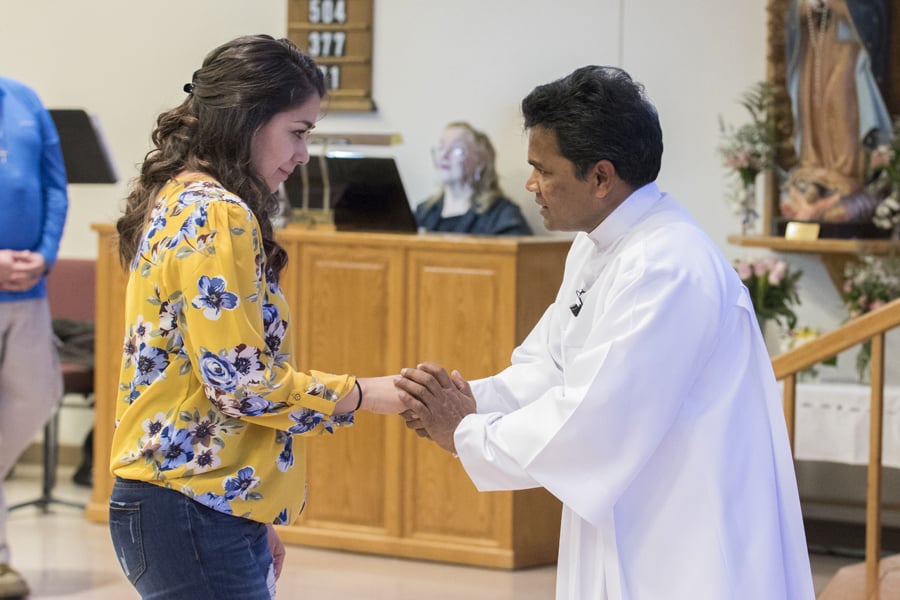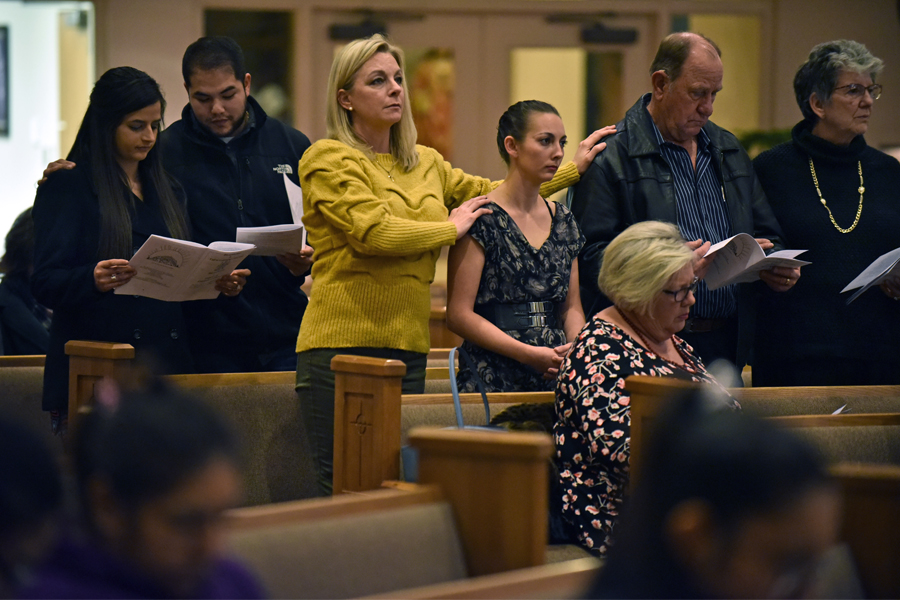Called by name

Father Balaji Boyalla shakes hands with every catechumen and candidate Feb. 10 at Our Lady of Lourdes Parish in Mineral Wells. (NTC photo/Jayme Shedenhelm)
GRANBURY — David Trout began watching videos on Catholicism to repudiate the faith — his brother had converted to Catholicism. But the longtime Baptist soon became “fascinated, like a bug to a light.”
On Feb. 10, Trout stood with about 60 others during the Rite of Election and Call to Continuing Conversion at St. Frances Cabrini Parish in Granbury, the last major step before entering the Catholic Church.
Trout is looking forward to being received into the Catholic Church at the Easter Vigil Mass at St. Ann Parish in Burleson, so he will “be able to share with my brothers and sisters in the Body of Christ.”
Seven Rites of Election were held in the diocese during the week that began Lent. During the rite, three signs punctuate the service of prayers, Scripture, and music. First, sponsors present their candidate (a person previously baptized in a Christian faith) or catechumen (unbaptized) to the bishop or his delegate and vouch that he or she is prepared to enter the Church.
A second symbol occurs when each parish presents their Book of the Elect, signed by the catechumens and candidates. The bishop then adds his signature.
Deacon Don Warner, director of Liturgy and Worship, explained the Book of the Elect represents that each person is called by name individually, by Christ and by the Church.
In the third special act, the bishop shakes the hand of each catechumen or candidate and individually welcomes them to the Church. “This is an important part of the process,” Dcn. Warner said. “The bishop is today’s apostle in our midst.” Because the line of apostolic succession traces back to the original Twelve Apostles, the bishop represents the Church dating back to Christ as he greets the catechumens and candidates.
After the Rite of Election, catechumens are known as the “Elect,” because the Church has elected them to receive the sacraments of initiation at the Easter Vigil Mass.
For many, the Rite of Election is their first encounter with the universality of Catholicism. “The Church, the body of Christ, is bigger than a local parish,” explained Dcn. Warner.
The seven Rites of Election were primarily attended by catechumens, candidates, their families, and their sponsors. But those of us who are already members of the Church also have a role, continued Dcn. Warner.

Sponsor Becky Bentke, left, places her hands on candidates Britiney Zamora and Jack Hearn during the Rite of Election conducted by Fr. Fernando Preciado at St. Frances Cabrini Catholic Parish in Granbury, Feb. 10, 2018. (NTC Photo/Ben Torres)
First, we must pray that those experiencing the call to join the Church will have a conversion of heart. Second, we must be an example of how to live as Catholic Christians. Lastly, he said, we must help the new members of our faith become an active part of the parish family.
According to Tara Tollett, the RCIA director of St. Frances Cabrini Parish, the Rite of Election can be considered the last step towards the goal of full communion with the Church. However, she views the rite as the “beginning of the journey” of a lifelong relationship with Christ and His Church. After the rite, the Elect and candidates should “feel part of the Church — loved, accepted, and supported.”
Her fellow RCIA director at St. Ann Parish concurred. Annabell Lee said, “I hope the Rite of Election helps the Elect and candidates know how much God loves them. God has called them by name to partake at His table. I hope they gain more zeal for Christian transformation.”
